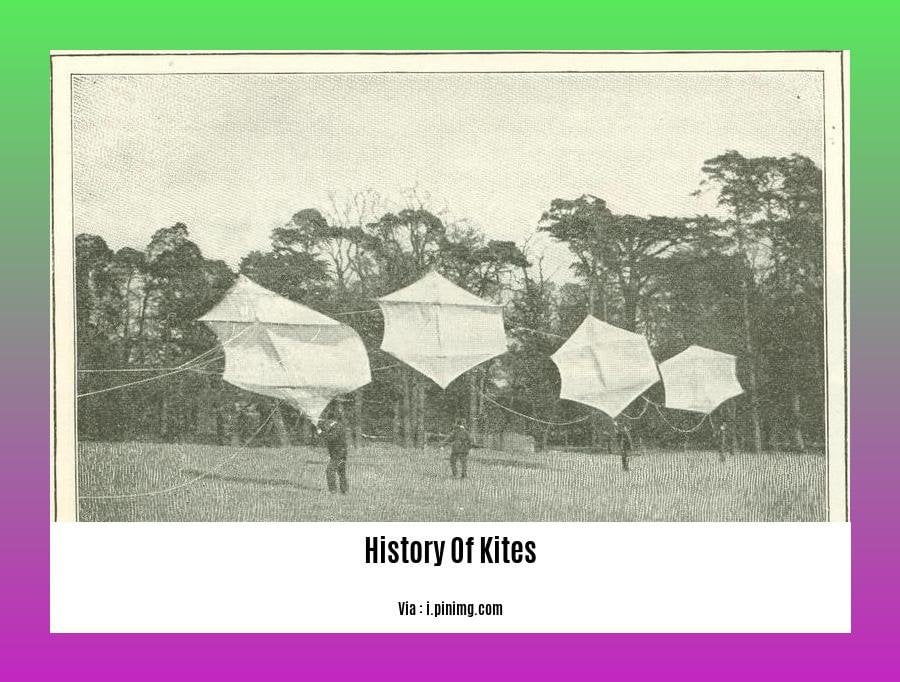– A Comprehensive Journey Through the History of Kites: From Ancient Origins to Modern Marvels –
The history of kites is a captivating tale that spans centuries, traversing diverse cultures and technological advancements. This article delves into the fascinating world of kites, exploring their humble beginnings in ancient China, their evolution into sophisticated aerial innovations, and their enduring significance in modern society. Through an examination of historical records, scientific discoveries, and cultural traditions, we trace the remarkable journey of kites, uncovering their role as pioneers in understanding flight and inspiring human ingenuity.
Key Takeaways:
- Kites originated in China over 2,000 years ago.
- They were initially crafted from silk and bamboo.
- Kites spread throughout Asia and were used for various purposes.
- Marco Polo introduced kites to Europe in the 13th century.
- Kites became significant in scientific research during the 18th and 19th centuries.
- Kites have inspired creative uses, such as kite surfing, photography, and fighting.
- Kites remain popular today for recreation, sport, and cultural expression.
History of Kites

The history of kites is a captivating tale spanning centuries, entwined with cultural traditions, scientific advancements, and artistic expression.
Ancient Beginnings
Kites trace their roots to ancient China, soaring through the skies over 2000 years ago. Crafted from silk and bamboo, early kites took on various shapes, from simple rectangles to intricate dragons. They adorned religious ceremonies, festivals, and art forms.
Spread to Asia
From China, kites spread to other Asian countries, captivating people with their ability to dance in the wind. They became popular for religious ceremonies, festivals, and artistic expression in Japan, Korea, India, and Southeast Asia.
Introduction to Europe
In the 13th century, Marco Polo introduced kites to Europe, where they quickly gained popularity. Europeans adopted them for recreation and military purposes, using them for signaling and aerial reconnaissance.
Scientific Research
During the 18th and 19th centuries, kites became tools for scientific research. Scientists like Benjamin Franklin and Alexander Graham Bell used them to study meteorology, electricity, and the flight of birds.
Creative Applications
Beyond traditional uses, kites have inspired countless creative applications. From kite surfing and kite photography to kite fighting and kite carriage, these aerial marvels have expanded their horizons.
Modern-Day Popularity
Today, kites continue to captivate people worldwide for recreation, sport, education, and cultural expression. Whether flown for fun, flown as art, or flown for competition, kites remain a timeless symbol of human ingenuity and the enchantment of flight.
Discover the rich ancient Chinese origins of kite flying, a tradition that has captivated imaginations for centuries. From vibrant kite festivals around the world to the mastery of kite construction, delve into the fascinating history of this beloved pastime.
History of Kites Facts

Imagine this: a canvas suspended in mid-air, dancing gracefully with the wind. That’s the magic of kites – a spectacle that has fascinated humans for millennia. Let’s dive into history of kites facts that will make you soar high with knowledge:
- Ancient Origins: Believe it or not, kites have been gracing our skies for over 2,800 years! They took flight in ancient China, crafted from bamboo, silk, or leaves.
- From China to the World: These airborne marvels spread through Asia like wildfire, becoming an integral part of cultural traditions.
- Scientific Soaring: In the 18th century, Benjamin Franklin and other scientists used kites to unlock the secrets of electricity and meteorology. Who knew kites could be the key to scientific discoveries?
- The Kite Legacy: Kites laid the foundation for a technological revolution. They inspired the Wright brothers as they took to the skies with their groundbreaking airplane.
- Military Might: Remember war kites? They were the ancient equivalent of drones, used for military signaling and aerial warfare.
Key Takeaways:
- Kites have a rich history dating back to ancient China.
- Early kites were crafted from natural materials like bamboo and silk.
- Kites played a crucial role in scientific advancements.
- The development of kites paved the way for aviation.
- Kites have been employed for both recreational and military purposes.
Relevant URL Sources:
History of Kites in China
China has a rich and fascinating history of kites, which stretches back over two millennia. The first known kites, dating from around 500 BC, were simple flat shapes made from silk and bamboo. These early kites were used for military purposes, such as signaling and surveillance.
Over time, kites became increasingly popular in China for both recreation and art. By the 10th century, the Chinese had developed a wide variety of kite designs, including flat kites, box kites, and animal-shaped kites. Kites were also used in religious ceremonies and festivals.
In the 13th century, Marco Polo introduced kites to Europe. From there, kites quickly spread to other parts of the world and became popular for recreation and sport. Today, kites are flown all over the world, and there are many kite-flying festivals held each year.
Key Takeaways:
- Kites were invented in China around 2,300 years ago.
- They were initially used for practical purposes such as signaling and scaring away birds.
- Kites quickly became popular for recreation and art.
- Kites spread to other countries in the 13th century.
- Kites are still popular today for recreation, sport, and cultural expression.
Relevant URL Sources:
- The Top 10 Facts on Chinese Kites for Chinese New Year 2023
- The Evolution Of Classic Kites: From Ancient China to Modern Times – Classic Kites
FAQ
Q1: When and where did kites originate?
A1: Kites originated in China over 2000 years ago, during the Warring States Period.
Q2: What were early kites made of?
A2: Early kites were made of bamboo and silk, or sometimes leaves and reeds.
Q3: How did kites spread to other parts of the world?
A3: Kites spread to other Asian countries by the 13th century, and later to Europe and the Americas by the 16th century.
Q4: Who was the first person to use kites for scientific research?
A4: Benjamin Franklin was one of the first people to use kites for scientific research, particularly in the study of electricity.
Q5: What are some modern uses for kites?
A5: Modern uses for kites include kite surfing, kite photography, kite fighting, and kite carriage.
- Unlock 6000+ words beginning with he: A comprehensive analysis - April 20, 2025
- Mastering -al Words: A Complete Guide - April 20, 2025
- Master Scrabble: High-Scoring BAR Words Now - April 20, 2025
















